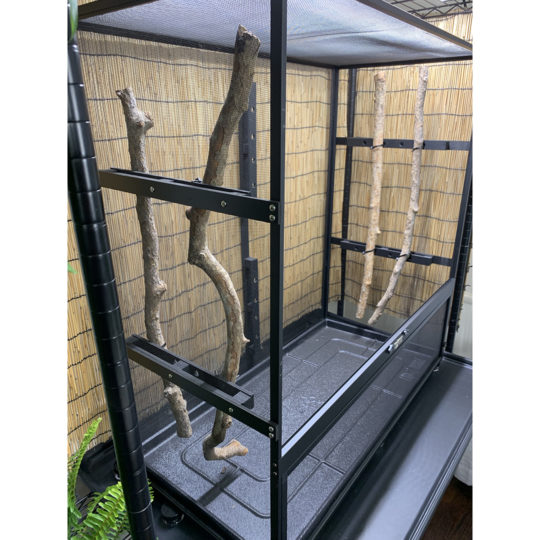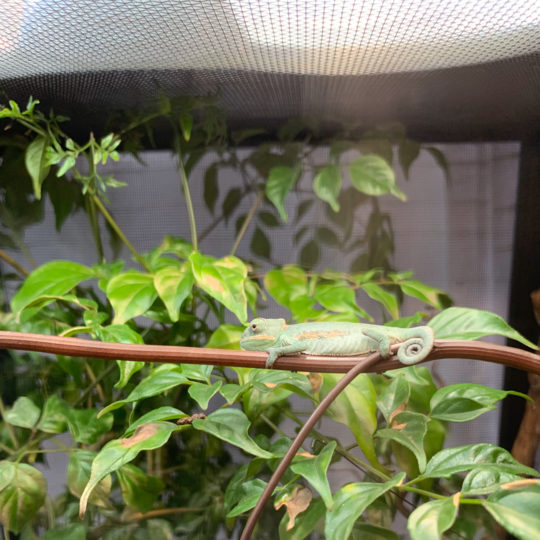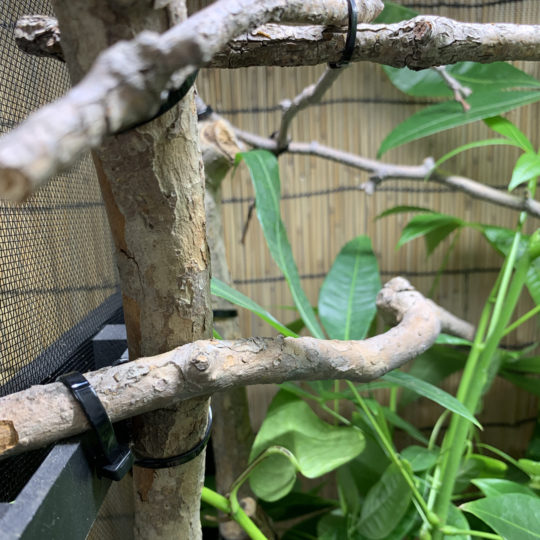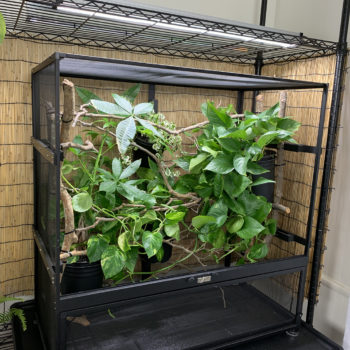Summary: The Screen Chameleon Cage
- Screen cages have the widest margin of error
- Screen cages have the maximum ventilation and minimum control
- Screen cages can be made inexpensively, but there is a wide range of quality
- Get a screen cage if your ambient temperature is close to your chameleon’s preferred range
Podcast Player
Anatomy of a Typical Screen Cage

Screen cages are usually made from aluminum window screening or some type of rolled or extruded aluminum. Most have been made from the same type of screen panels that go on house windows. Though these are seen to be flimsy – and, as individual pieces they are – when screwed together into a six sided box (a cage shape) they provide a stable, but lightweight structure. This has given us chameleon keepers a huge advantage where we can have the large cages our chameleons need without the usually expected weight. Although a common compliant is that the cages are “flimsy”, the fact is that there is no need for strong material. There is no use case that requires the cage to support great weight. Other more substantial framing can be used, but the benefits of doing so do not start to outweigh the cost and weight until the cage gets to be over 4′ in one dimension. After that there are 1″x 1″ aluminum extrusions with many premade connectors which can be used.
The one thing to beware of is that mass produced, imported cages often cut corners to cut cost. These cages have been known to occasionally come in with painted metal screen which quick rusts a hole in your cage. Although this is not common since the public outcry against such low quality, it is worth checking. If a magnet sticks you have found a rust potential. This goes for screen, frame, screws, and hinge pins.
The Pros and Cons of 100% Ventilation
The essentially 100% ventilation of screen cages allows the inside of the cage to match the outside ambient temperature and humidity. If your environment matches closely with your chameleon’s natural environment then a screen cage is a good choice.
A screen cage also has the advantage that there is a wide margin of error. Since you are really heating and humidifying the entire room, a basking lamp needs only be calibrated to the proper temperature at the basking spot. You really don’t have to worry about anything outside the immediate cone of heat until you succeed in heating up the entire room and are now affecting the ambient conditions.
It is the same for humidity. The column of fog from your fogger does not stick around once the fogger is stopped.
Of course, the advantage is also a disadvantage. You can get away with leaving the heat lamp on a little longer without affecting the temperature at the other end of the cage, but likewise, if you need the ambient conditions warmer or more humid you will have a challenge.
The more ventilation you have the more your cage will mimic the ambient room conditions. The more solid sides you have the more you can create an environment different from ambient.
Heating the Screen Cage

You cannot heat a screen cage. If your ambient temperature is too cold then you need to look into solid side caging. What we can do is provide a heating boost through a basking light. And this works well for many species. If you home is in the mid 70s F, which is very comfortable for humans, then your ambient conditions are perfect for the most common chameleon species. All they would need is a heat boost in the morning that consists of turning on an appropriately strong heat lamp. After a couple of hours the chameleon will be done basking and will find those comfortable mid 70s areas to hang out in. In a screen cage the heat will be there until the second you shut it off so you need to use screen cages in a location where you do not need to modify the environment beyond an initial sunning in the morning.
An incandescent light is the most commonly used heat source with screen cages. It makes sense to combine heat and light as that is what chameleons are used to. The main caution with any cage with a screen tip is to ensure that your heat lamp does not super heat the screen and burn sensitive toes if they crawling on the top. A stronger bulb further away is better than a smaller wattage bulb closer to the cage (or sitting on top the cage). Since chameleons do not generally need heating at night there is no need to work with lightless heaters such as ceramic heat emitters (CHE). Regardless of the heating element, with a screen cage there will be no residue of heat once the heating unit is shut off.
Screen Cages with Humidity & Hydration

Humidity is the biggest problem with screen cages. The standard humidity cycle that chameleons are used to in the wild is a spike in humidity at night and a decrease during the day. Many chameleons are comfortable with a decrease down to 40% and then a good deal of live plants can increase the humidity a little bit in the cage microclimate. The problem comes with the night time humidity which would rise in the wild to even fogging conditions. Early morning fog rolls in and helps with hydration just from breathing in the moist air. But typical human homes are not designed to hold high humidity so the ambient humidity usually does not get to the natural high. If you desire to replicate this you will be challenged in a screen cage. Just like heat, any humidifying action on the cage is really fighting the entire room conditions. The fogger can produce a stream of fog into the cage, but it does not build on itself. It dissipates as soon as the fogger is turned off and the only parts that are fogged is the small area in that narrow tube of fog. For this reason you will see a number of people wrapping their screen cage in three sides of plastic tarp. This allows some trapping of humidity.
Screen cages and misters have an adversarial relationship. Misters are wonderful, but they just don’t stop at the screen cage side. So, in an all screen cage, you must balance mist nozzle power with strategic direction to keep the spray from wetting your house walls or furniture. Once again, the wrapping of two or three sides in plastic wrap is done to keep misting inside the cage. It is not hard to see the benefit of hybrid cages as these hacks on the screen cages create a homemade hybrid cage. I like to use bamboo mats along the outside because it appears more natural.
Branching Screen Cages

Installing chameleon appropriate branching is a fundamental challenge in screen cages. The screen side is not strong enough to be an anchor point for any weight. Though many people will us push pins and other methods for attaching a branch to the screen, any method which makes the screen take the weight of something inside invites a ripped screen sooner or later. Your strength point is the aluminum frame. You can tie branches to the side frame with fishing line. Using the strength of the aluminum frame is the working strategy behind the Dragon Strand Dragon Ledges which is a commercial product designed specifically to solve this problem. If you prefer to create a solution yourself, you can do so by placing a lattice along the inside wall or screwing a thick branch to the framing. Just make sure that the weight is transferred to the frame and not held by the screen. Which ever method you use, chameleons will want horizontal branches to perch on.
Screen Cages and the Outdoors

One of the most perfect qualities of a screen cage is that they are suited to be used outdoors and will allow your chameleon to get natural sunlight. You do not want to use solid side cages with outdoors caging as they will store or reflect heat and direct sun could overheat your chameleon. The screen cages allow the natural breezes, sun, and rain. Whether you are planning to bring your screen cage outside for an hour or you are planning for a permanent caging situation, pay attention to whether any components rust. Most of the entry level cages will start to rust after a couple months outdoors. While this is not a huge deal, it is just disappointing when you have to replace a cage after a year or two of the plants establishing themselves. It all depends on how elaborate your plans are!
But taking your chameleons outdoors has many things to watch out for. Listen to this podcast episode for all the warnings and preparations before you do it.
Bill Strand
Outdoor Chameleon Keeping
What to look for in a Screen Cage
From a distance (or on the internet) screen cages look pretty much the same. Here are some things to check off your list when shopping for a screen cage.
Size: Pictures do not do a good job of communicating the size of a screen cage so you’ll have to go in with an idea of the numbers you are looking for. Consider an adult cage to be in the range of 24″W x 24″D x 48″H or 36″W x 18″D x 36″H.
Aluminum screen: This is not the problem it use to be. The mass market cages that are imported from overseas are done so for cost savings and they put their innovation into reducing cost. One way this was done was to build the cages with painted metal. This would quickly rust and produce a hole in the side of your cage. Presumably, the public outcry forced the mass market companies to insist on aluminum screening. Although these decisions could have been influenced by aluminum tariffs. The real story is unknown, but verify that aluminum screen is being used. I am unaware of even entry level cages being made with metal instead, but these things often change. The easiest way to tell is to see if a magnet sticks to your cage screen. If it does then you have a rust potential. This is nothing to be worried about. Just know that the screen could rust out in the future.
Rust proof hinges – The marketing behind these cages all like to say they are aluminum screen and rust proof! Except that there are many more things that go on these cages and sometimes aluminum or stainless steel is not a cheap option. Screws, door handles, and especially hinge pins, tend to rust on these “rust proof” cages. A simple magnet will show you where the rusting parts are. Screws and door handles can be replaced, but door hinges are usually riveted on one side. A hinge pin rusting out cannot be easily replaced. Most people do only indoor keeping so this is a consideration that must be seriously evaluated by keepers planning on including outdoor keeping in their husbandry.
Flip-up Service Door. A common chameleon cage feature for the last couple decades is a short flip up panel at the bottom front. This “service door” allows us to clean the floor of the cage with the minimum disruption to the occupant. This is not a simple feature to implement as it reduces the structural integrity of the entire cage. Each manufacturer must decide how they will (or won’t) compensate for this. Note that some cage designs deal with this situation by not including a service door (Zilla takes the lead here). This feature is not as useful if you have potted plants on the floor and the floor panel wouldn’t be moved unless the plants were removed anyways. But if you intend to use Dragon Ledges or any other method to mount your plants to the sides and keep the floor clear, the Service door becomes a feature with high value.
Drainage Tray Availability. The most glaring evidence of a cage company that makes products for keeping chameleons, but does not understand chameleon keeping is the lack of a drainage tray. Many cage manufacturers, unfortunately, only offer substrate trays for their cage line. As shown earlier, the substrate tray (which is inserted inside the cage instead of underneath the cage like a drainage tray) is not an appropriate water collection tool. Substrate trays keeps poop, water, and escaped feeders together for an extremely unhygienic mix. A quick review: substrate trays go inside the cage and should be used to give the cage a soil floor. A drainage tray goes under the cage, collects the excess water, and keeps the waste water separated from the chameleon. At the time of this writing, Dragon Strand is the only major chameleon caging manufacturer to offer drainage trays for their cages. If you need to find a drainage tray for your screen cage either check Dragon Strand for a drainage tray that fits the 24″ x 24″ footprint (25″ Universal Drainage Tray) or else search online for dog crate replacement trays, oil pans, or other trays that will fit your cage’s footprint.
Screen Cages Available
The following reviews cover the major manufacturers of screen cages in the market. There are always new start ups coming up and going away just as quickly. This list will include only companies that have a noticeable presence in the community and have been in business for at least three years.
The term “mass market” is used to describe companies large enough to have a distribution type structure which places them in major pet stores on a global basis. This list includes Exo-Terra, ZooMed, and Zilla.I
In direct sales companies you will usually buy directly from the company such as with Dragon Strand and DIY Cages.
Note: As an Amazon Associate I earn from qualifying purchases.
[supsystic-tables id=5]
Dragon Strand Chameleon Caging Company
The Dragon Strand Chameleon Caging Company was founded by Bill Strand, who is also the founder of this Chameleon Academy and host of the Chameleon Academy Podcast! The company was created to produce products whose main purpose is to solve the problems we chameleon keepers and breeders have.
The product line spans screen cages, hybrid cages, and the patented Dragon Ledges.
Dragon Strand products are built in the USA and currently ships mostly within the US. Canadian and European shipping is possible for smaller items, but shipping rates on large cages are prohibitive.
Dragon Strand has switched over their indoor screen cage line to having white PVC solid back panels. This is to protect the house walls from misting overspray. Although this officially makes it a hybrid cage, it is included here as the husbandry would be identical to a full screen cage as far as frequency and duration of any hydration methods. The ventilation is “screen cage” ventilation. The indoor Screen Cage format is available in both 2’x2’x4′ and 4’x2’x4′ sizes.
A screen cage designed specifically for the outdoors is available in the all-screen format
The entire Screen Cage line-up is as follows:
[supsystic-tables id=6]
Large Screen Atrium
This cage measures 46.75″ wide x 23″ deep x 48″ high. It includes a set of eight Dragon Ledges and three Hydration Mounts which accept Mist King and Cli-Mist nozzles. It also has an entry point for 1/4″ tubing to allow access for the Exo-terra Monsoon mist head or a 1/4″ plant watering drip system.
Zoo Med
ZooMed has a line of standard screen cages that are designed for mass market. They are the cheapest cages that are commercially available. All cage sizes have an appropriately sized substrate tray available for purchase. Unfortunately, there are no drainage trays available. ZooMed offers the following sizes:
ZooMed ReptiBreeze Open Air Screen Cages
ReptiBreeze Nano = 10″ x 10″ x 12″ with available Nano Substrate Tray
ReptiBreeze Small = 16″x16″ x 20″ with available Substrate Tray
ReptiBreeze Medium = 16″ x 16″ x 30″ with available Substrate Tray
ReptiBreeze Large = 18″ x 18″ x 36″ with available Substrate Tray
ReptiBreeze XL = 24″ x 24″ x 48″ with available Substrate Tray
The Chameleon Kit
ZooMed has created the “Chameleon Kit” which is the industry’s most popular first cage. It is unfortunate as it is not adequate as a cage set-up. It is popular because it is cheap, not because it is good for chameleons. The UVB bulb is too weak to reach more than an inch or so and there is no way to mount either the included vine or one spring of fake plant. The carpet included is not appropriate for chameleon husbandry as it only provides a nice wet foundation for poop and escaped feeder insects to mingle in a moist environment. The official statement from ZooMed customer service as to the cage’s inadequacy is that the cage is not meant for long term use, but only to get the chameleon home. You may read it here: ZooMed Customer Service Response Regarding The Chameleon Kit.
Use the Substrate Tray that fits the Reptibreeze Medium
Reptibreeze LED Deluxe
ZooMed has dabbled in providing a screen cage with an acrylic door. This is technically a hybrid cage, but will be listed here because the addition of the acrylic door is only aesthetic and does not offer environmental benefit. This does not take away from the value of seeing your chameleon without the “screen door” effect, but it does not get to be a “hybrid” cage for the purposes of this classification. These two cages also have a string of LEDs around the top. They do provide some light, but are more gimmicks than a solid husbandry feature. You will still want substantial lighting up top.
ZooMed offers the LED Deluxe in two sizes,
Medium (16″ x 16″ x 30″) with available Substrate Tray
XL (24″ x24″ x 48″) with available Substrate Tray
Materials
The Reptibreeze cages are designed for indoor use only and certain components will rust if they are left outside in the elements for more than a couple months.
The Reptibreeze Nano is a relatively inexpensive way of housing babies individually,
The Reptibreeze XL has been positioned as the low price leader for 2′ x 2’x4′ tall screen cage in the community. Although they do use cheaper materials, this cage does the job.
The Reptibreeze LED Deluxe XL gives you an acrylic front door to see your chameleon more clearly. The LEDs are of limited value. Do not have any of the colors on at night.
Exo-Terra
Exo-Terra is the most recent entrant into the mass screen cage market with a number of unique dimensioned screen cages. It is not clear to me why these dimensions were chosen. It is curious that they bucked the 48″ tall trend and they do not go beyond 36″ tall. There is a shipping penalty for boxes over 48″ in the US and this is a good way to get around it. Though Exo-Terra is a global company and I am not sure the US shipping quirks play into their decisions. Going only to 36″ tall is a bit of a handicap when it comes to chameleons because we need space, but there is one of their cages, the Large X-Tall that they extend to 36″ wide and this actually makes it the best choice of the three mass market cage manufacturers. Width is more important to chameleons than height and the 36″ width makes an effective cage for our standard adult chameleons.
The drawback to the Exo-Terra cages is that the floors are actually substrate trays. It is very easy for insects to escape and we chameleon people need drainage trays – not substrate trays. But the Large X-Tall is worth figuring out a work around. And we will be doing that in this class segment. Check out this cage build for how to create a drainage tray for the Exo-Terra Large/X-Tall
The Exo-Terra lineup
Small/Tall = 18” x 18” x 24”
Small/X-Tall = 18” x 18” x 36”
Medium/X-Tall = 24” x 18” x 36”
Large/X-Tall = 36” x 18” x 36”
At 36″W x 18″D x 36″H, the Large/X-Tall size is an effective cage shape for a single adult Panther, Veiled, or Jackson’s Chameleon. The cage comes with a substrate tray, but does not have a drainage solution.
Please price check the following link as there is a good chance this one is much cheaper
https://www.joshsfrogs.com/exo-terra-screen-terrarium-large-x-tall.html
The Medium/X-Tall cage is 24″W x 18″D x 36″H cage. One concern is that the door latches push the door away from the side frame to make a solid latch and leaves a gap.
Please price check the following link as there is a good chance this one is much cheaper
http://www.joshsfrogs.com/exo-terra-screen-terrarium-medium-x-tall.html
Zilla
Zilla is the third of the mass market cage manufacturers. They have two wide format cages available. These cages have the unique feature in that they offer an entry point for electrical cords. As we chameleon people have very few devices that we would put inside the cage this is an interesting feature, but not of use to us. The cage has a solid lower panel so cleaning is not as convenient as cages with the flip-up service doors. Although cleaning is now more difficult, this design does result in a more stable cage.
Fresh Air Screen Habitat Small: 18″ x 12″ x 20″
Fresh Air Screen Habitat Large: 30″ x 18″ x 30″
The Small Fresh Air Screen Habitat at 18″ x 12″ x 20″ is suitable for raising up a juvenile chameleon, but is not a contender for most chameleon species.
The Large Fresh Air Screen Habitat is 30″ x 18″ x 30″ and this is the minimum I recommend for adult common chameleons, though it must be done very carefully to ensure their needs are accommodated in this tight space.
DIY Cages
Small business company run by a reptile hobbyist. Offers the standard pillar style cages in silver color with a step up in quality from the standard mass market offerings. Cages have door handles on the main doors, a flip up service door in the front, and removable floor panel. The last “rust” check caught the hinges and screws as rusting so this cage is not suitable for long term outdoor use, but provides a solid indoor cage option. Note: As of May 2020, most cages have been out of stock for many months. I will populate the cage options here should stock be re-established.
More Research On Cage Types?
Would you like to check out the other cage types before making your final decision? Pick your type below!
Navigation
This module describes the basic types of chameleon cages and is part of the course Selecting a Chameleon Cage which, in turn, is a class within the even larger Term 1: Getting Started With Chameleons. If you have selected your cage then it is time to the course Setting Up Your Chameleon Cage!













